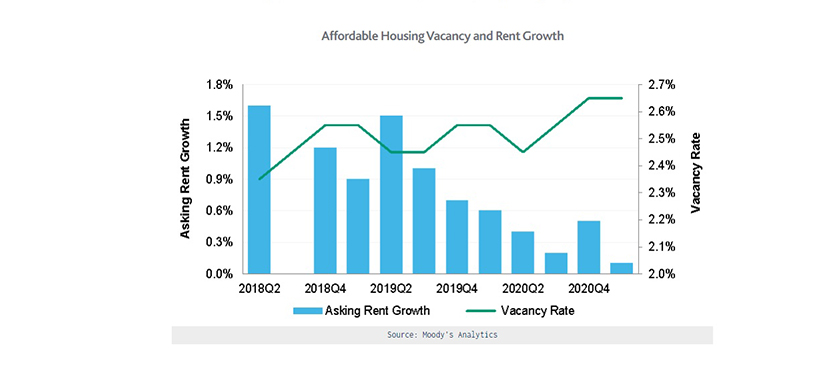
‘New Cracks’ in Affordable Housing Foundation

Fitch Ratings, New York, said the coronavirus pandemic “created new cracks” in the already fragile foundation of affordable housing.
Fitch Senior Director Mikiyon Alexander said low-income households have faced “daunting” affordability challenges for several years, with more than 10 million low-income renter households facing economic stress and substandard housing. “COVID-19 caused an economic contraction felt among millions of American of many economic strata, and those at the most vulnerable level of the economic scale saw their tenuous grip loosen on housing security,” he said.
Fitch released an affordable housing report, Covid-19 Complicates Housing Affordability, last week.

Moody’s Analytics, New York, reported the national vacancy rate for affordable housing created using the Low-Income Housing Tax Credit held steady at a very low 2.6 percent in the first quarter. Data Quality Analyst David Caputo said the vacancy rate has remained between 2.0 percent and 2.6 percent since the firm began tracking this sector. “It is expected to stay within that range for the foreseeable future,” he noted.
Caputo said the affordable housing sector saw just 0.5 percent inventory growth during the first quarter as 5,197 new completions delivered. But he said 2021 could be reasonably strong year with 37,000 completions despite the “modest” first-quarter completions. “Not including 2020 for COVID-19 reasons, the affordable sector has had a history of having their first quarter construction totals tend to lag behind the following quarters, so construction is expected to pick up as the year goes on,” he said.
Rents grew 0.1 percent during the quarter, bringing the average asking rent to $964, Caputo said. He forecast affordable housing property rents could grow 1.8 percent this year to finish 2021 at $981.
The Fitch report said the pandemic intensified the rising input costs, generational shifts in demand, changes in regulations and slower wage growth that were already in place and led to affordable housing supply deficits. “Affordable housing stock has decreased, causing demand to outstrip supply and leaving a gap that particularly pressures the affordable housing segment,” the report said.
Alexander said only seven homes were built for every 10 households formed between 2010 and 2016. “This creates a strong competition for the existing affordable housing supply for both homeownership and rental housing,” he said. “This intensifying competition makes the housing shortage more acute for those in the market for affordable housing.”
